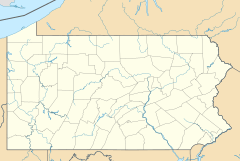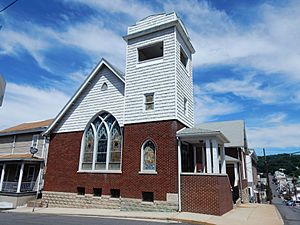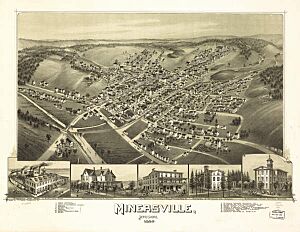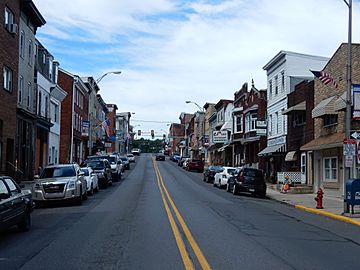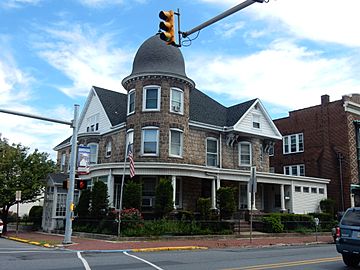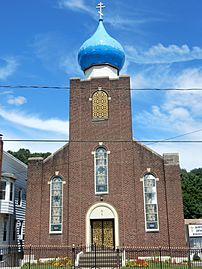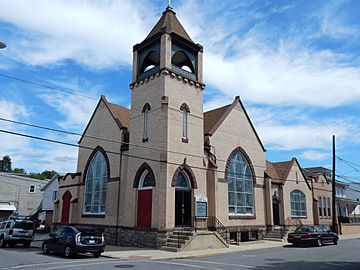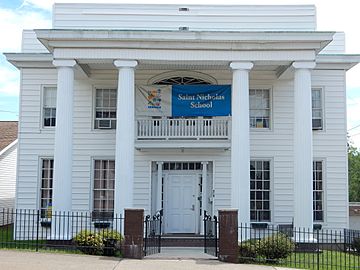Minersville, Pennsylvania facts for kids
Quick facts for kids
Minersville, Pennsylvania
|
|
|---|---|
|
Borough
|
|
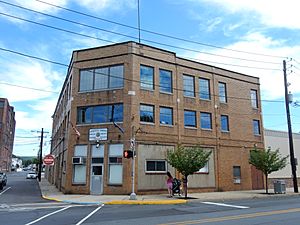
Minersville Borough Office on Sunbury Street
|
|
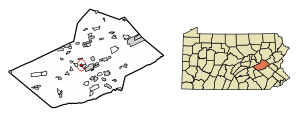
Location of Minersville in Schuylkill County, Pennsylvania.
|
|
| Country | United States |
| State | Pennsylvania |
| County | Schuylkill |
| Settled | 1783 |
| Incorporated | 1831 |
| Government | |
| • Type | Borough Council |
| Area | |
| • Total | 0.66 sq mi (1.70 km2) |
| • Land | 0.66 sq mi (1.70 km2) |
| • Water | 0.00 sq mi (0.00 km2) |
| Population
(2020)
|
|
| • Total | 4,370 |
| • Density | 6,651.45/sq mi (2,568.97/km2) |
| 420 | |
| Time zone | UTC-5 (Eastern (EST)) |
| • Summer (DST) | UTC-4 (EDT) |
| Zip code |
17954
|
| Area code(s) | 570 |
| FIPS code | 42-50088 |
| Website | https://minersvillepa.gov/ |
Minersville is a small town, called a borough, in Schuylkill County, Pennsylvania, United States. It's known for having lots of Anthracite coal underground. In 2020, about 4,388 people lived there.
Minersville is located about 50.8 miles (81.8 km) west of Allentown. It's also about 100 miles (160 km) northwest of Philadelphia and 138.4 miles (222.7 km) west of New York City.
Contents
History of Minersville
Early Settlement and Coal Discovery
In 1783, a person named Adolph Oliver Busch traveled through a valley. He built a log cabin and a sawmill near the Schuylkill River. Later, he built a tavern, which was called the "Half Way House." This was because it was halfway between Reading and Sunbury. The road nearby was called the Kings Highway, created in 1770.
Early settlers mostly worked with timber. They floated logs down the river to sell them. Coal was discovered in 1799 by Necho Allen. However, actual mining didn't start until 1814. In 1818, Jacob Reed opened another coal mine in the Minersville area.
Growth of the Coal Industry
The coal industry grew quickly after the Schuylkill Haven and Mine Hill Railroad was finished. This railroad helped transport the coal. Many immigrants came to Minersville to work in the mines. English and Welsh miners arrived first. Then came German and Irish immigrants, followed by many other groups.
As more people moved to the town, it needed more planning. Titus Bennett designed the town in 1830. On May 2, 1830, citizens held an election to choose a Burgess, which is like a mayor. Samuel Richert was elected. Minersville officially became a borough on April 1, 1831.
Important Court Case
The Minersville Area School District was part of a famous court case in 1940. It was called Minersville School District v. Gobitis. This case was about a family whose children were Jehovah's Witnesses. Their religion taught them not to salute the flag or say the Pledge of Allegiance.
The case went all the way to the Supreme Court. At first, the Court decided that the school could make students salute the flag. However, this decision was not popular and was soon changed. Another case, West Virginia State Board of Education v. Barnette, overturned it. This new ruling said that students could not be forced to salute the flag.
Geography of Minersville
Minersville is located at 40°41′26″N 76°15′37″W / 40.69056°N 76.26028°W.
The United States Census Bureau says the borough covers about 0.7 square miles (1.7 km2) of land. There is no water area.
Population Information
| Historical population | |||
|---|---|---|---|
| Census | Pop. | %± | |
| 1840 | 1,265 | — | |
| 1850 | 2,951 | 133.3% | |
| 1860 | 4,024 | 36.4% | |
| 1870 | 3,699 | −8.1% | |
| 1880 | 3,249 | −12.2% | |
| 1890 | 3,504 | 7.8% | |
| 1900 | 4,815 | 37.4% | |
| 1910 | 7,240 | 50.4% | |
| 1920 | 7,845 | 8.4% | |
| 1930 | 9,392 | 19.7% | |
| 1940 | 8,686 | −7.5% | |
| 1950 | 7,783 | −10.4% | |
| 1960 | 6,606 | −15.1% | |
| 1970 | 6,012 | −9.0% | |
| 1980 | 5,635 | −6.3% | |
| 1990 | 4,877 | −13.5% | |
| 2000 | 4,552 | −6.7% | |
| 2010 | 4,397 | −3.4% | |
| 2020 | 4,388 | −0.2% | |
| 2021 (est.) | 4,393 | −0.1% | |
| Sources: | |||
In 2000, there were 4,552 people living in Minersville. Most residents were White (98.51%). About 23.8% of households had children under 18. The average household had 2.22 people.
The median age in Minersville was 41 years old. This means half the people were younger than 41, and half were older.
Education
The local school district for Minersville is the Minersville Area School District.
Fun Facts About Minersville
- Minersville celebrated its 175th anniversary in 2006 with a parade.
- Joe Balsis (1921–1995), a famous pool champion, was born in Minersville.
- Benjamin C. Christ, a general in the American Civil War for the Union, was from Minersville.
- Big Diamond Raceway is in Minersville. It hosts weekly dirt track racing during certain seasons.
- The Pottsville Maroons, a professional football team, played at Minersville Park in the 1920s.
- Minersville is home to Railway Restoration Project 113. This group takes care of the Minersville Railway Station and a special steam locomotive, Central Railroad of New Jersey #113. The locomotive has been fixed up and sometimes takes people on trips!
Notable People
- M. I. Parcell (1854-1916) - a politician
Gallery
See also
 In Spanish: Minersville (Pensilvania) para niños
In Spanish: Minersville (Pensilvania) para niños


